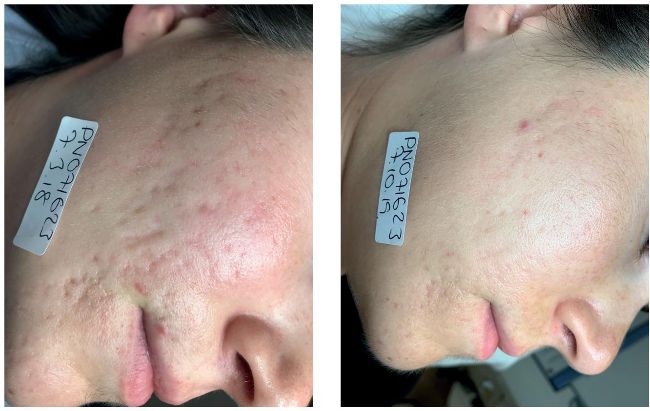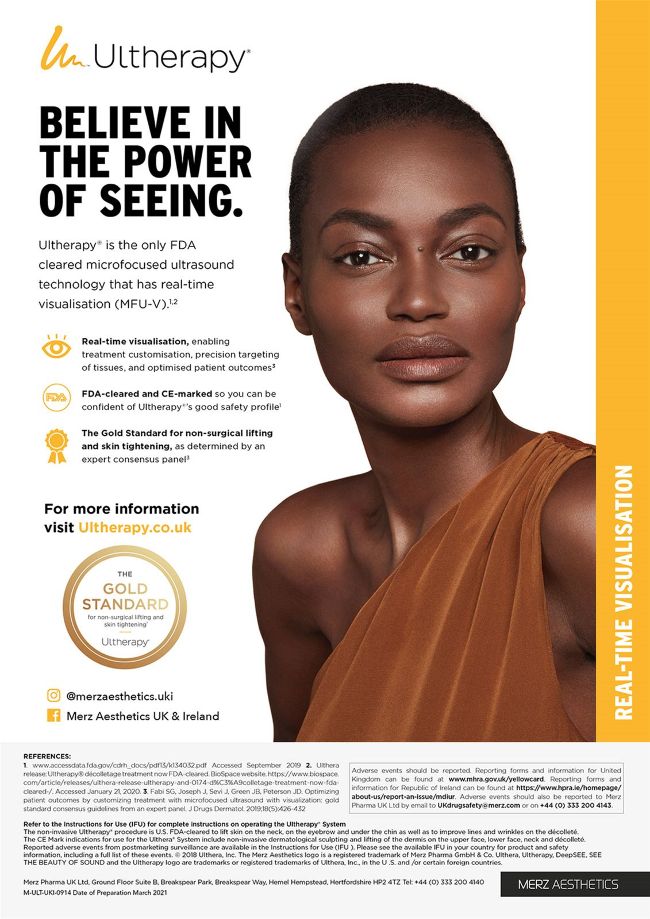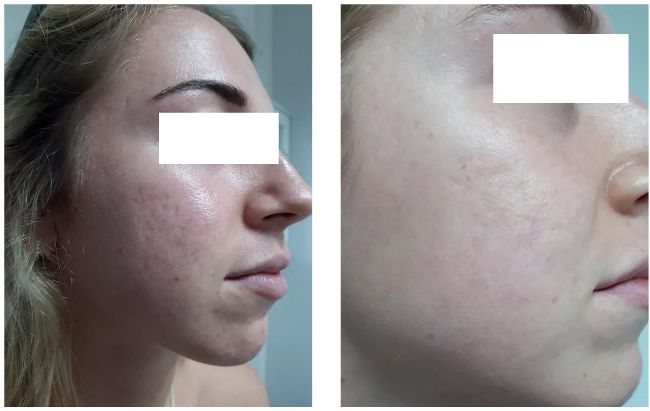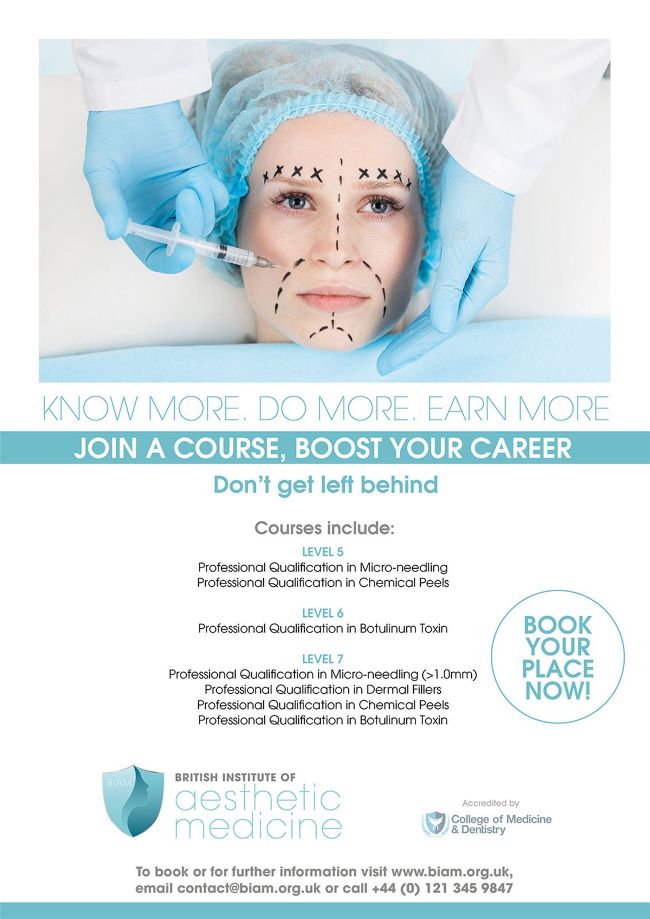TREATING ACNE WITH LASER
On the spot
Laser specialist Kerry Belba explores the best options for treating acne and acne scarring with laser
KERRY BELBA
Kerry Belba is a laser practitioner, trainer, key opinion leader and owner of Laser Skin Solutions in Bournemouth. She is the first aesthetic laser practitioner to have been voted onto the British Medical Laser Association (BMLA) board. Follow Kerry on Instagram: @LaserskinsolutionsUK
It is often said that a picture paints a thousand words. Indeed, this is certainly applicable to many of the Instagram selfies I see on a daily basis. The dichotomy of skin photos tend to fall within two camps; the “flawless” skin-selfie and the candid daily struggle of acne and acne-scar sufferers the world over. Recommendations of beauty treatments, “magic” creams and natural remedies abound, but from my 17 years of laser experience, while I have seen some great results on acne using topicals alone, in my opinion, nothing quite separates the wheat from the chaff like laser and light-based treatments for the successful treatment of not only acne, but in particular, acne scarring.

Left: before, Right: after three treatments with Lynton Lumina Resurface fractionally-ablative Erbium YAG laser. Client treated at Laser Skin Solutions
Laser treatments for acne vulgaris were first pioneered by the eminent Dr Tony Chu at Imperial College London with the NLite Laser, using a wavelength of 585nm. At the time, it was thought that the laser light produced by this wavelength was, among other things, killing the acnecausing bacteria on the skin. While blue light at around 415nm has the highest absorption peak for acne bacteria, it was thought that the multiple lower absorption peaks at around 585nm were having the same effects. Apparently not, according to Professor Chu. Swabs taken from skin treated with the NLite laser showed no change in the bacterial cultures on the skin. So what exactly is the pathology of acne and why did the very first acne trials succeed in the early 2000s if laser light wasn’t killing the bacteria?

According to Professor Chu, “Propionibacterium acnes, often referred to as P.acnes (or more recently, renamed cutibacertium or C.acnes) is the target for an inflammatory response induced by specific T cells. This results in a cascade of inflammatory cytokines and an endpoint of pus formation. The NLite laser (now called Regenlite) works as a medicine in blocking the inflammatory cytokines by massive upregulation of the anti-inflammatory cytokine transforming growth factor beta (TGFb).
“TGFb also upregulates collagen production in the skin so can have an impact on scarring. It can also induce regulatory T cells which can turn off the inflammatory response to P.acnes and result in total resolution of acne. The beauty of this treatment is that it is very well tolerated, leaves no mark on the skin, is safe to use during pregnancy and can last up to three months between treatments.
“At least two of my patients went into full remission after one treatment, and followup for scar revision over two years saw no relapse,” he says.
RAY OF LIGHT
There is no doubt that laser and light treatment for acne has been a total gamechanger for clients and patients desperate for acne-free skin. In a world where the social media selfie is so important, clients are more results-focused than ever before and certainly more discerning than their “Yellow Pages” counterparts of the Chu/ NLite clinical-trial era. Social media aside, we’re well aware of the devastating psychological impact acne can have on people’s self-esteem, but following the pioneering laser acne studies in the early 2000s, for those who can afford it, there is light at the end of the tunnel.
Acne can sometimes be problematic, but from my experience, with the right “light tools”, as I call them in my clinic, it can also be pretty straightforward to treat. The most successful treatment protocols in my clinic involve using a resurfacing peel prior to laser or LED treatment. Removing dead skin cells from the uppermost layers of the stratum corneum allows for better light penetration into the skin and less refracted light scattering on the skin’s surface. Back in 2004, a skin peel would often be performed a whole week beforehand, requiring double the amount of clinic time and client visits in order to get the same results.

Left: before, Right: after four treatments with Lynton Lumina IPL. Client treated at Laser Skin Solutions Bournemouth
With the advancements of the capabilities of topicals, it is now possible for certain skin peels to be applied immediately prior to laser treatment, providing that the acids are fully neutralised before removing and lasering the skin. The results speak for themselves. Acne-free skin can be obtained from as little as three treatments, although I always recommend four to six treatments as a precaution. Hormonal acne, however, can be extremely tricky to treat, which is why taking a holistic approach in order to try to understand the pathophysiology of an individual’s acne is not only vital to getting better treatment outcomes, but enables practitioners to better manage their client or patient expectations.
ALL THINGS CONSIDERED
I very much take a holistic approach when it comes to treating acne. Not only is this the most ethical route, but it leads to better treatment outcomes. The causes of an individual’s acne can vary enormously, and understanding why a client is presenting with this often debilitating condition tends to get better treatment results.
Advanced skin facialist and aesthetician Andy Millward agrees: “I treat my acne clients with the same approach as my clients with rosacea and other chronic inflammatory skin issues, in that rather than trying to pinpoint a single root cause of their acne, I view it as multiple contributing factors that are fueling the inflammation and acne,” he says. Millward, whose clinic is based in Birmingham, goes on to explain that “adopting a purely allopathic approach to treating acne doesn’t work in the majority of cases. In fact, it often just suppresses it for a short time, only to come back worse.”
My own clients have experienced similar scenarios and come to me as a last resort, often devastated that their prescribed antibiotics haven’t worked and desperate to see some results. From my experience, combining a holistic approach with products and light-based treatments is without a doubt the answer to treating this inflammatory skin disease.
BATTLE SCARS
While wavelengths between 415nm and 585nm in the visible light spectrum are extremely effective at treating acne vulgaris, the various scarring types often left behind require wavelengths at the complete opposite end of the spectrum. The target in the skin for acne scarring is no longer the inflammation or the bacteria, but the water content in the layers of the epidermis which are heated to such a degree that ablation occurs, instigating the body’s woundhealing response and subsequent repair.
CO2 and other fractionally-ablative resurfacing lasers are the most effective means of dealing with unwanted acne scarring. Tiny microscopic holes are created in the epidermis by heating the water content to over 100°C, causing ablation and resurfacing, while the intense heat which travels down into the dermis instigates collagenesis. The softening of the scars, or in some cases, their complete removal, can be dramatic and life-changing for the client or patient but will vary according to their age and their scar type.

Left: before, Right: after two treatments with Lynton Lumina Resurface fractionally-ablative Erbium YAG laser. Courtesy of Blank Canvas Lasers, Benfleet, Essex
Acne scars fall into four categories: rolling, boxcar, ice-pick and hypertrophic. Rolling and boxcar are the most straightforward to treat, with ice-pick being the most problematic. Client selection and identifying the scar type is crucial to getting the best results. Age and lifestyle are significant factors to consider; a 28-yearold non-smoker with rolling scars will get significantly better results than a 60-yearold smoker with ice-pick scars. The ability to build collagen at a young age, without the negative effects of smoking, cannot be underestimated when it comes to laserskin resurfacing. Nevertheless, laser skin resurfacing, whether fully or fractionally ablative, is generally considered to be the best option when it comes to dealing with acne scarring.
THE BEST RESULT
Fully-ablative skin-resurfacing treatment creates more downtime for the client and should only be performed by a medical practitioner within a hospital or doctorled clinic. Often, antibiotics and anti-viral medications will need to be prescribed to prevent infection due to the removal of the upper layers of the skin. Fractionallyablative skin resurfacing however, requires no antibiotics with redness lasting up to five days. This is significantly less than the two weeks of intense side effects with fully ablative laser followed by the four-to-six weeks of full skin recovery. While fullyablative CO2 laser is undoubtedly the goldstandard treatment for skin resurfacing, not all clients or patients will be willing to undergo this type of invasive treatment, and some may simply not be able to take time out to recover. Being able to offer a choice of fractional skin resurfacing, or the ability to refer to another practitioner, will ensure the best treatment outcomes for your clients.

Having expert clinical support from your laser supplier will only serve to increase excellent treatment outcomes. Consider becoming a member of the British Medical Laser Association (BMLA), and you will have a winning formula for your laser clinic. During the last 18 months of covid madness, the support I have received from top physicists and clinical trainers, combined with the covid protocols issued by the BMLA, has been instrumental in guiding me in performing plume-generating treatments like fractional skin resurfacing safely for practitioner and client alike.
In the end, laser practitioners who “hit the spot” are those who are not just trained in how to use the system in front of them, but who take the time to educate themselves in the condition they are treating and match that knowledge with the best technology available. We are only ever as good as our training and the tools at our disposal. So, choose equipment wisely, never stop learning and use this winning formula to create your own before-and-after pictures that paint a thousand words.